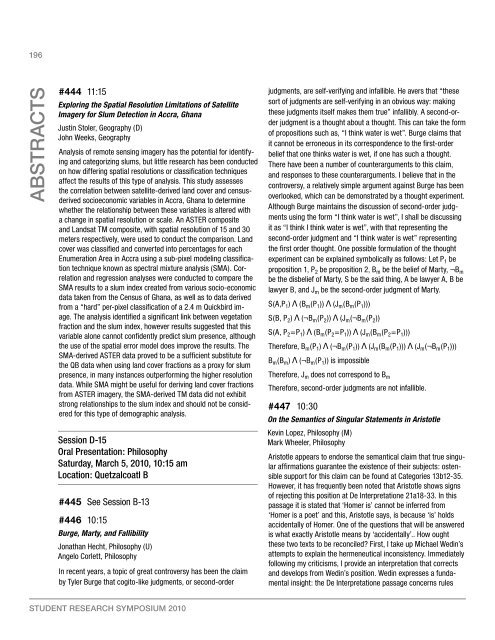STUDENT RESEaRch SympoSiUm 2010 - Graduate and Research ...
STUDENT RESEaRch SympoSiUm 2010 - Graduate and Research ...
STUDENT RESEaRch SympoSiUm 2010 - Graduate and Research ...
You also want an ePaper? Increase the reach of your titles
YUMPU automatically turns print PDFs into web optimized ePapers that Google loves.
196<br />
AbstrActs<br />
#444 11:15<br />
Exploring the Spatial Resolution Limitations of Satellite<br />
Imagery for Slum Detection in Accra, Ghana<br />
Justin Stoler, Geography (D)<br />
John Weeks, Geography<br />
Analysis of remote sensing imagery has the potential for identifying<br />
<strong>and</strong> categorizing slums, but little research has been conducted<br />
on how differing spatial resolutions or classification techniques<br />
affect the results of this type of analysis. This study assesses<br />
the correlation between satellite-derived l<strong>and</strong> cover <strong>and</strong> censusderived<br />
socioeconomic variables in Accra, Ghana to determine<br />
whether the relationship between these variables is altered with<br />
a change in spatial resolution or scale. An ASTER composite<br />
<strong>and</strong> L<strong>and</strong>sat TM composite, with spatial resolution of 15 <strong>and</strong> 30<br />
meters respectively, were used to conduct the comparison. L<strong>and</strong><br />
cover was classified <strong>and</strong> converted into percentages for each<br />
Enumeration Area in Accra using a sub-pixel modeling classification<br />
technique known as spectral mixture analysis (SMA). Correlation<br />
<strong>and</strong> regression analyses were conducted to compare the<br />
SMA results to a slum index created from various socio-economic<br />
data taken from the Census of Ghana, as well as to data derived<br />
from a “hard” per-pixel classification of a 2.4 m Quickbird image.<br />
The analysis identified a significant link between vegetation<br />
fraction <strong>and</strong> the slum index, however results suggested that this<br />
variable alone cannot confidently predict slum presence, although<br />
the use of the spatial error model does improve the results. The<br />
SMA-derived ASTER data proved to be a sufficient substitute for<br />
the QB data when using l<strong>and</strong> cover fractions as a proxy for slum<br />
presence, in many instances outperforming the higher resolution<br />
data. While SMA might be useful for deriving l<strong>and</strong> cover fractions<br />
from ASTER imagery, the SMA-derived TM data did not exhibit<br />
strong relationships to the slum index <strong>and</strong> should not be considered<br />
for this type of demographic analysis.<br />
Session D-15<br />
Oral Presentation: Philosophy<br />
Saturday, March 5, <strong>2010</strong>, 10:15 am<br />
Location: Quetzalcoatl B<br />
#445 See Session B-13<br />
#446 10:15<br />
Burge, Marty, <strong>and</strong> Fallibility<br />
Jonathan Hecht, Philosophy (U)<br />
Angelo Corlett, Philosophy<br />
In recent years, a topic of great controversy has been the claim<br />
by Tyler Burge that cogito-like judgments, or second-order<br />
<strong>STUDENT</strong> RESEARCH SYMPOSIUM <strong>2010</strong><br />
judgments, are self-verifying <strong>and</strong> infallible. He avers that “these<br />
sort of judgments are self-verifying in an obvious way: making<br />
these judgments itself makes them true” infallibly. A second-order<br />
judgment is a thought about a thought. This can take the form<br />
of propositions such as, “I think water is wet”. Burge claims that<br />
it cannot be erroneous in its correspondence to the first-order<br />
belief that one thinks water is wet, if one has such a thought.<br />
There have been a number of counterarguments to this claim,<br />
<strong>and</strong> responses to these counterarguments. I believe that in the<br />
controversy, a relatively simple argument against Burge has been<br />
overlooked, which can be demonstrated by a thought experiment.<br />
Although Burge maintains the discussion of second-order judgments<br />
using the form “I think water is wet”, I shall be discussing<br />
it as “I think I think water is wet”, with that representing the<br />
second-order judgment <strong>and</strong> “I think water is wet” representing<br />
the first order thought. One possible formulation of the thought<br />
experiment can be explained symbolically as follows: Let P 1 be<br />
proposition 1, P 2 be proposition 2, B m be the belief of Marty, ¬B m<br />
be the disbelief of Marty, S be the said thing, A be lawyer A, B be<br />
lawyer B, <strong>and</strong> J m be the second-order judgment of Marty.<br />
S(A,P 1) (B m(P 1)) (J m(B m(P 1)))<br />
S(B, P 2) (¬B m(P 2)) (J m(¬B m(P 2))<br />
S(A, P 2=P 1) (B m(P 2=P 1)) (J m(B m(P 2=P 1)))<br />
Therefore, B m(P 1) (¬B m(P 1)) (J m(B m(P 1))) (J m(¬B m(P 1)))<br />
B m(B m) (¬B m(P 1)) is impossible<br />
Therefore, Jm does not correspond to Bm Therefore, second-order judgments are not infallible.<br />
#447 10:30<br />
On the Semantics of Singular Statements in Aristotle<br />
Kevin Lopez, Philosophy (M)<br />
Mark Wheeler, Philosophy<br />
Aristotle appears to endorse the semantical claim that true singular<br />
affirmations guarantee the existence of their subjects: ostensible<br />
support for this claim can be found at Categories 13b12-35.<br />
However, it has frequently been noted that Aristotle shows signs<br />
of rejecting this position at De Interpretatione 21a18-33. In this<br />
passage it is stated that ‘Homer is’ cannot be inferred from<br />
‘Homer is a poet’ <strong>and</strong> this, Aristotle says, is because ‘is’ holds<br />
accidentally of Homer. One of the questions that will be answered<br />
is what exactly Aristotle means by ‘accidentally’.. How ought<br />
these two texts to be reconciled? First, I take up Michael Wedin’s<br />
attempts to explain the hermeneutical inconsistency. Immediately<br />
following my criticisms, I provide an interpretation that corrects<br />
<strong>and</strong> develops from Wedin’s position. Wedin expresses a fundamental<br />
insight: the De Interpretatione passage concerns rules


